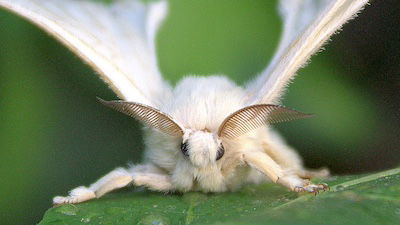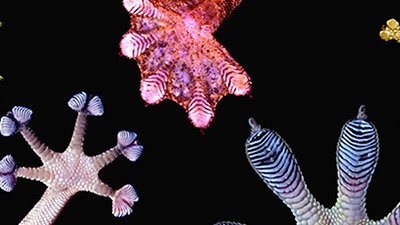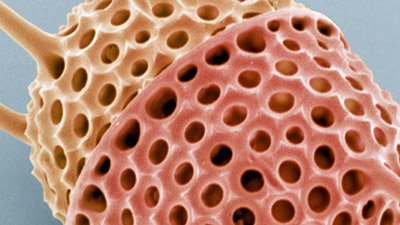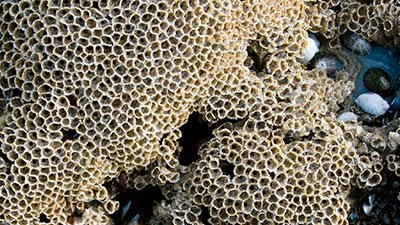Biomimicry
Biomimicry in Technology
Where do scientists find ideas to improve existing technology? Increasingly, the marvels of life—from the microscopic to the massive—inspire engineering breakthroughs. Knowingly or not, scientists are imitating God’s own incredible designs.
Copying God’s Design
By copying the world around us, scientists believe they can find innovative solutions to almost any problem imaginable. Biomimetics (or biomimicry) has already led to the development of technology as diverse as airplanes, Velcro, windshield wipers, and sharkskin swimsuits.
Bombardier Beetle
The amazing Bombardier beetle has long been a favorite of intelligent design advocates, who ask how the insect’s amazing self-defense mechanism could have arisen. Now, researchers have imitated that incredible mechanism.
Gecko Feet
Thanks to God’s amazing design of gecko feet, we could one day live in a world where tires grip smooth surfaces, climbing gloves and boots grip rocks, and even Spider-Man suits are a reality. But the gecko, with its fantastic ability to scamper up glass walls and ceilings, still wins by a foot.
News About Biomimicry
-
Feb. 27, 2025 from Ken Ham Blog
Human designers are inspired by the ultimate Designer, and this results in some neat technological innovations—including a new technology using the antennae of silkworm moths.
Articles About Biomimicry
-
Jan. 15, 2023 from Answers Magazine
Some creatures produce tenaciously sticky substances and researchers hope to mimic these materials to create safer surgical procedures.
-
Feb. 3, 2019 from Answers Magazine
Scientists have long tried to understand how geckos can walk on walls and ceilings, even on smooth glass.
-
Aug. 21, 2016 from Answers Magazine
It’s easy to see why dogs are a hunter’s best friend. But sailors? Go topside to examine a swabbie’s shoe, and you’ll find your answer.
-
May 26, 2013 from Answers Magazine
Mankind was not the first to invent glass. Since creation, untold trillions of little creatures, called diatoms, have made their homes out of glass.
-
Aug. 19, 2012 from Answers Magazine
The intricate folding of the beech leaf is an ingenious design. Scientists are using patterns found in nature.
-
Magazine ArticleGod Invented It FirstJan. 1, 2012 from Answers Magazine
The marvelous designs in the biological world have inspired a new field of science, called biomimicry.
-
Magazine ArticleBug BotsJan. 1, 2012 from Answers Magazine
What if we could build light-weight flying machines that flap their wings and maneuver silently, without conventional airplane engines?
-
Magazine Department ArticleThe Day Superman CrashedJan. 1, 2012 from Answers Magazine
As long as there have been humans, men and women have looked at what God has made and tried to copy it.
-
Dec. 4, 2011 from Answers Magazine
God’s creation has inspired many of man’s greatest designs.
-
Robotic Insects Mimic God’s Own DesignSept. 3, 2011 from News to Know
Energizer bug’s backpack is a battery of God’s own design.
-
Magazine ArticleA Whale of a DesignJuly 10, 2011 from Answers Magazine
Where do inventions come from?
-
Replicating the Bombardier BeetleJan. 8, 2011 from News to Know
The Bombardier beetle is a favorite of intelligent design advocates, who ask how the insect’s self-defense mechanism could have arisen in stepwise fashion.
-
Scientists Turning to Creation for InspirationJuly 3, 2010 from News to Know
Once again, scientists are turning to God’s creations for inspiration.
-
Marine Animal RobotsNov. 7, 2009 from News to Know
Are a series of robots made in nature’s image, or were they inspired by God’s designs? Or could it be both?
-
Magazine Department ArticleGreatest Form of FlatteryApril 1, 2009 from Answers Magazine
The design of pterodactyls has inspired the design of an unmanned spy drone.
-
April 1, 2009 from Answers Magazine
Researchers are studying the Sandcastle worm, which produces a glue.
-
Cockroaches Inspire RobotsFeb. 14, 2009 from News to Know
Robot designers are taking a cue from lizards and cockroaches!
-
New Nautical Device Takes Design Cues From ClamsDec. 13, 2008
An incredible new nautical device takes design cues from the humble Ensis directus clam.
-
Engineers Take Cues From Fish In New Energy Turbine DesignDec. 6, 2008
Energy-generating turbines could take a cue from fish, according to a new study.
-
Superglue From A Sea Worm May Mend BonesNov. 29, 2008
Fracture a bone? Let us put it back together with our worm glue.
-
Engineers Try to Emulate Sticky Gecko FeetSept. 13, 2008 from News to Know
Hours of research continue to be spent investigating—and trying to emulate—the incredible “sticky” gecko foot, one of God’s most crafty creations.
-
Nature Inspires Technology To Replicate Spider SilkMay 3, 2008
Another of God’s creative designs has inspired human technology—a device that attempts to replicate a spider’s production of silk.
-
Scientists Abuzz over More Efficient Web ServersJan. 5, 2008
In another example of technology inspired by nature, a honeybee dance has helped scientists design a new model for Internet server technology.
Recommended Resources

Answers in Genesis is an apologetics ministry, dedicated to helping Christians defend their faith and proclaim the good news of Jesus Christ.
- Customer Service 800.778.3390
- Available Monday–Friday | 9 AM–5 PM ET
- © 2026 Answers in Genesis











